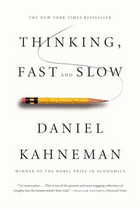Thinking Fast and Slow
A very good book, packed with so many interesting facts and studies. Thinking, Fast and Slow has been my introduction to behavioral psychology, and it was a fascinating read. However, it’s a complex book, and I took a long time to finish it. The studies and examples cited really get you thinking.
Here are a few takeaways: The books explains that we have 2 systems of thinking. System 1 is (fast, intuitive) and System 2 (slow, deliberate). A simple math example he states will explain this: A bat and a ball together cost $1.10. The bat costs $1.00 more than the ball. How much does the ball cost? System 1 jumps to answer 10 cents, but after thinking again, you realize that for the bat to cost exactly $1.00 more, the ball has to cost 5 cents. It’s System 2 that makes you slow down and rethink. Even though in many situations we’d be better off trusting our System 2, we tend to rely on System 1.
Our actions and choices are affected by biases. Here are some. I have tried to give the gist of the biases, but you should read the studies and articles to actually understand them.
The Anchoring bias.It happens to us more often than we think. For example, an item at the supermarket might be discounted at 50% off the original price. The item may never have been worth the original price, but we anchor to that higher price and feel it’s a great deal when we buy it.
Availability bias, where we overestimate the likelihood of events based on how recently they happened and how much the media covered them. Fears around terrorist attacks and plane crashes are some examples.
Hindsight bias is one we all tend to suffer from—our favorite line being “I knew it all along,” or “If only it had been done this way…”
Then there’s confirmation bias—we believe things we want to believe in.“It cannot be any other way”
The loss aversion bias, which drives many of our conservative choices - it is worse losing 100 Euros than gaining 100 Euros.
The framing effect - how we prefer “90% success” over “10% failure,” even though it means the same thing.
Overconfidece bias - how we can be overly confident in our abilities and judgments making us underestimate risks and overestimate our knowledge.
Sunk cost fallacy - how we might continue a failing project, only because we have already invested so much time, money and effort in it.
And a few more biases like Halo effect where we believe if the person is good at one thing, they must be good at another things as well.
Each of these biases affects our thinking and it is very interesting to read about them and realize that you have been in similar situations explained and have made irrational decisions.Its an eye-opener and it makes you question your choices and encourages you to think more slow than fast.
© 2025 Sindhuja Cheema Enzinger. All Rights Reserved.

